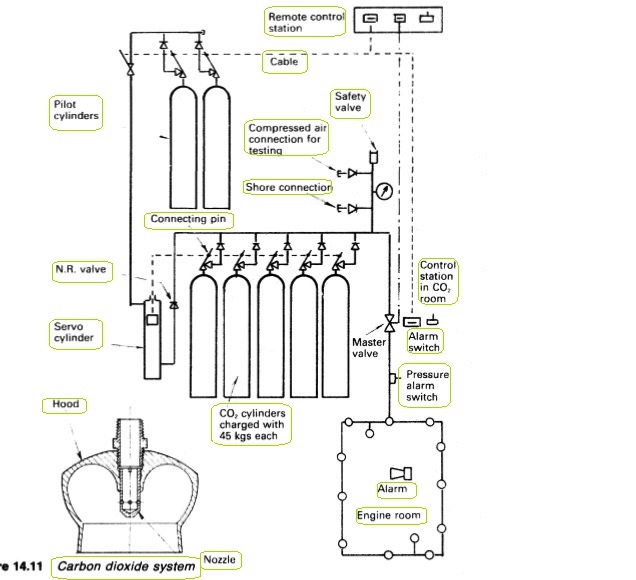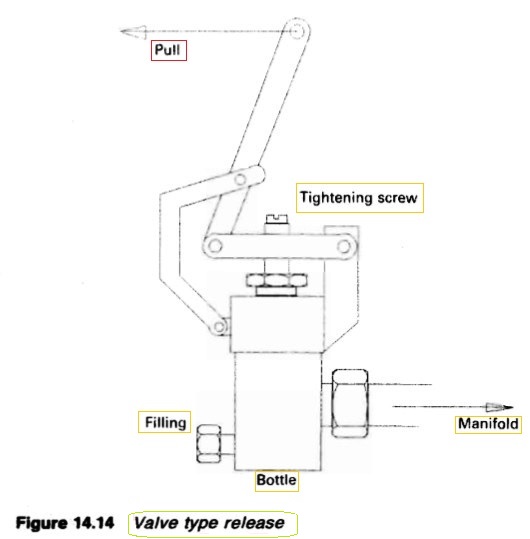
Home page||Fire protection||
CO2 fire extinguishing installations for cargo ship machinery spaces
Fire extinguishing installations employing CO2 stored under pressure at
ambient temperature are extensively used to protect ships' cargo compartments,
boiler rooms and machinery spaces. When released the CO2 is distributed
throughout the compartment, so diminishing the relative oxygen content and
rendering the atmosphere inert.
The quantity of CO2 required is calculated from the gross volume of the
largest cargo space or machinery compartment, whichever is the greater of the
two. Additional CO2 may be required for machinery spaces containing large
air receivers. This is because air released from the cylinders through fusible
plugs or over pressure release, would increase oxygen content in the space.
The high pressure carbon dioxide (CO2) system shown (Figure 14.11) is
supplied from storage bottles of CO2 which are opened by a servo-piston
operated gang release. A safety feature to protect against accidental release is
provided by the master valve on the pipe to the engine room distribution
nozzles.

Figure : Carbon dioxide system
The CO2 system is used if a fire is severe enough to force evacuation of the
engine room or to prevent entry. An alarm is sounded by an alarm button as
the CO2 cabinet is opened and in some ships there is also a stop for the engine
room fans incorporated (Figure 14.12). Before releasing the CO2, personnel
must be accounted for and the engine room must be in a shut down condition
with all openings and vent flaps closed. It is a requirement that 85% of the
required quantity of gas is released into the space within two minutes of
actuating the system release.
Figure 14.12

Figure : CO2 cabinet alarm
In the installation shown, the actuating handle opens pilot cylinders of CO2
and the gas from these pushes the piston in the servo-cylinder down, to
operate the gang release for the other bottles. To avoid sticking, all the handles
must be in good alignment. The bottle valves may be of the quick-release type
(Figure 14.13) where the combined seal and bursting disc is pierced by a cutter.
The latter is hollow for passage of liquid CO2 to the discharge pipe. An
alternative type of quick release valve (Figure 14.14) is held in place by a
hinged linkage arrangement until released.

Figure :CO2 cutter type quick release

Figure :Valve type release
Bottle pressure is normally about 5 2 bar (750lb/in2) but this varies with
temperature. Bottles should not be stored where the temperature is likely to
exceed 55 deg C. The seal/bursting discs are designed to rupture spontaneously at
pressures of 177 bar produced by a temperature of about 63°C. The master
valve prevents CO2 released in this way from reaching the engine room. Gas is
released by the relief arrangement on the manifold, into the CO2 space where,
in the event that the release was caused by a fire in the compartment, the fire
would be extinguished.
Rapid injection of CO2 is necessary to combat an engine room fire which has
attained such magnitude that the space has to be evacuated. Hence the rule that
85% of the gas must be released within two minutes. The quantity of gas
carried (a) must be sufficient to give a free gas volume equal to 40% of the
volume of the space except where the horizontal casing area is less than 40% of
the general area of the space, or (b) must give a free gas volume equal to 35% of
the entire space, whichever is greater. The free air volume of air receivers may
have to be taken into consideration.
The closing of all engine room openings and vent flaps will prevent entry of
air to the space. All fans and pumps for fuel, can be shut down remotely as can
valves on fuel pipes from fuel service and storage tanks.
CO2 bottles are of solid drawn steel, hydraulically tested to 22 8 bar. The
contents are checked by weighing or by means of a radioactive level indicator.
Recharging is necessary if there is a 10% weight loss.
Pipework is of solid drawn mild steel, galvanized for protection against
corrosion. The syphon tube in the bottle ensures that liquid is discharged from
the bottles. Without the syphon tube the CO2 would evaporate from the
surface giving a very slow discharge rate and, taking latent heat, would
probably cause the remaining CO2 in the bottle to freeze.
Summarized below general cargo ship fire protection equipments & guideline:
- Fire main system & related mechanism
The fire main
extends to the full length of the ship and from the machinery spaces to the
highest levels. Hydrants served by the main, are situated so that with suitable
hoses any area on the ship can be reached.
.....more
- CO2 fire extinguishing installation
Fire extinguishing installations employing CO2 stored under pressure at
ambient temperature are extensively used to protect ships' cargo compartments,
boiler rooms and machinery spaces. When released the CO2 is distributed
throughout the compartment, so diminishing the relative oxygen content and
rendering the atmosphere inert.
...... more
- Fire fighting equipments
Two independently powered pumps must be provided in all cargo ships of 1000 tons gross and over and in passenger ships of less than 4000 tons gross. Larger passenger vessels and passenger ferries must have three such pumps. The pumps are fitted with non-return valves if they are of the centrifugal type, to prevent loss of water back through open valves when not running.
..... more
- Details of fire detectors
A variety of devices are available for detecting fire in unmanned machinery
spaces but each has an ability to detect basically only one aspect. Thus, smoke
detectors based on the ionization chamber are able to recognize combustion
products but will not register radiation from a flame or heat.
.....more
- Machinery space fire & use of Walter Kidde CO2 system
Walter Kidde CO2 system employs pilot
CO2 cylinders to open the distribution system main stop valve and
subsequently the valves on the individual CO2 cylinders.
.....more
- Fire protection system for cargo holds
Holds for general cargo, have been protected against fire by fixed installations which deliver inert gas from an inert gas generator based on combustion of fuel (similar to the system available for inerting oil tankers) and halon systems.
.....more
- Low pressure CO2 storage
In some installations, the CO2 is stored in low pressure refrigerated tanks. The
cylindrical storage vessels are fabricated to the pressure vessel
requirements of the authorities. The tanks are of low temperature steel, fully
tested and stress relieved. They are mounted on supports designed to
withstand shock from collision.
..... more
- Halon system
Halon 1301 has the chemical formula CF3 Br being known as bromo-trifluoromethane.
It is a colourless, odourless gas with a density five times that of air and
extinguishes fire by breaking the combustion chain reaction.
.....more
- Multi-spray system for the machinery spaces
This system is similar to the sprinkler used in accommodation areas but the spray heads are not operated automatically. The section control valves (Figure 14.20) are opened by hand to supply water to the heads in one or more areas. Ready to use hoses can also be supplied. Fresh water is used for the initial charging and the system is brought to working pressure by means of the compressed air connection.
.....more
- Automatic sprinkler system
A network of
sprinkler heads is arranged throughout the spaces to be protected. Each sprinkler head is normally kept closed by a quartzoid bulb which is almost filled with a liquid having a high expansion ratio.
.....more
- Details various portable extinguishers & how to use ?
The first line of defence against fire in any area of the ship, is the portable fire extinguisher. Some common portable extinguishers that have been used at sea are described.
.....more
Home page||Cooling ||Machinery||Services ||Valves ||Pumps ||Auxiliary Power ||Propeller shaft ||Steering gears ||Ship stabilizers||Refrigeration||Air conditioning ||Deck machinery||Fire protection||Ship design
||Home ||
General Cargo Ship.com provide information on cargo ships various machinery systems -handling procedures, on board safety measures and some basic knowledge of cargo ships that might be useful for people working on board and those who working in the terminal. For any remarks please
Contact us
Copyright © 2010-2016 General Cargo Ship.com All rights reserved.
Terms and conditions of use
Read our privacy policy|| Home page||



